 |
| January 31, 2017 | Volume 13 Issue 04 |
Designfax weekly eMagazine
Archives
Partners
Manufacturing Center
Product Spotlight
Modern Applications News
Metalworking Ideas For
Today's Job Shops
Tooling and Production
Strategies for large
metalworking plants
Wheels:
It's all about change -- Ford GT supercar's digital display is dashboard of tomorrow

Like the glass cockpit in airplanes and race cars, the all-new Ford GT features an all-digital instrument display in the car's dashboard that quickly and easily presents information to the driver, based on five special driving modes.
The innovative digital instrument display is far advanced from the original Ford GT, when the cockpit was hardwired with a fixed set of analog gauges, buttons, and knobs across the dashboard that had to address almost every situation.
VIDEO: See the Ford GT all-digital instrument display.
"Driver focus and attention are key with such high performance," said Jamal Hameedi, chief engineer, Ford Performance. "We've designed the GT with a sleek digital instrument display that changes depending on driving mode in ways that are important and usable to the driver."
Ford engineers and designers created the state-of-the-art 10-in.-wide digital gauge cluster to be customizable, elegant, and able to tailor information to each drive mode to help ensure customers taking the Ford GT to its limits are provided the data they need to make critical decisions behind the wheel in the most efficient way.
Defining the visual future of in-car data
The Ford GT program presented a unique opportunity to reimagine the instrument cluster, further expanding what a connected car can be and previewing the future of Ford vehicles.
Its layout is designed around which data is most important, when to present it, and how to show information in a way that's most expedient for a driver to process.
VIDEO: The Ford GT all-digital instrument display explained.
The design is executed on a high-resolution display that matches the sleek, purpose-driven cabin. Data is conveyed in crisp, high-contrast graphics.
To test the initial design, Le Mans winner Scott Maxwell of Multimatic was invited to the Ford GT simulation lab to offer feedback. Maxwell suggested changing the tachometer to provide an expanded view of the EcoBoost V6 redline approach for greater peripheral visibility. The race car driver also recommended tweaks to the prioritization of performance information.
As advanced design work transitioned to putting prototypes on the road, Ford Performance reached out to suppliers at the cutting edge of data display.
Ford designers and engineers worked closely with Pektron (for electronic design, development, implementation, and manufacture) and Conjure (for graphical design) to create forward-looking renderings that are painstakingly animated, include highlighted font, color, and responsiveness, and avoid driver distraction and eye strain.
The five drive modes are easily accessed through steering wheel-mounted controls to help keep eyes and attention on the road and hands on the wheel.
Each mode presents information differently -- prioritizing what is crucial for each environment and tailoring the display to the given context.
How information is graphically displayed with each drive mode
Normal mode:
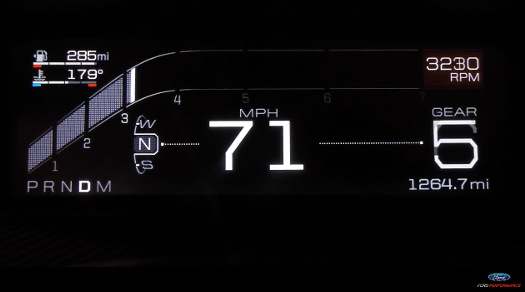
Displays information in a purposeful, businesslike manner. The theme is simple; the speedometer is centered and bold, gear selection is to the right, fuel and temperature are top left. The hockey-stick-shaped tachometer displays in a compressed scale for lower rpm, as the engine revs so quickly the lower counts mean almost nothing to the driver. The 3,000-to-7,000-rpm range dominates the top of the display.
Wet mode:
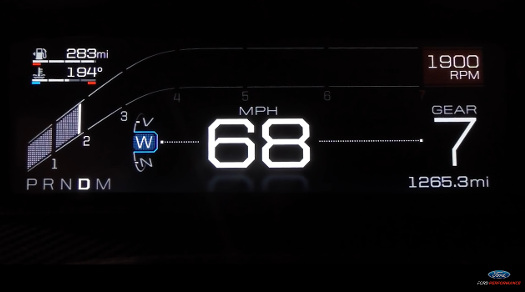
Sport mode:
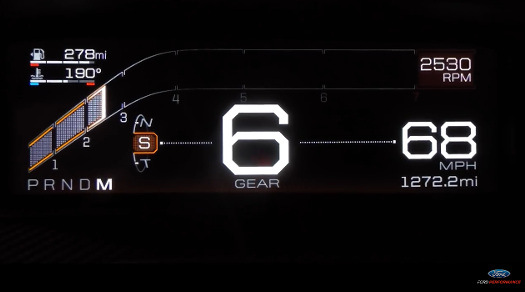
Track mode:
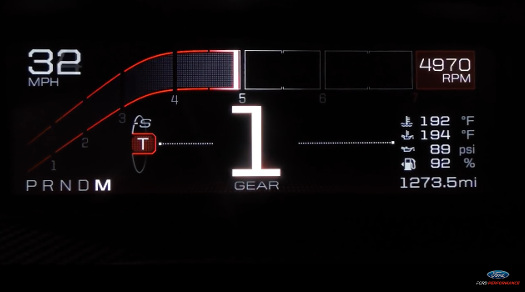
V-Max:
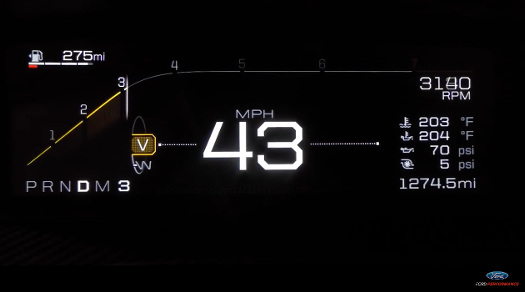
"We spent an enormous amount of time getting this just right," says Nick Terzes, Ford GT engineering supervisor. "The result is simple, but achieving simple perfectly can be a challenge." Joey Hand, winner of the 24 Hours of Le Mans at the wheel of a Ford GT, raved about the different drive modes recently on a visit to Las Vegas Motor Speedway. "This is exactly what I want to see when I want to see it," he said. "You guys did a great job."
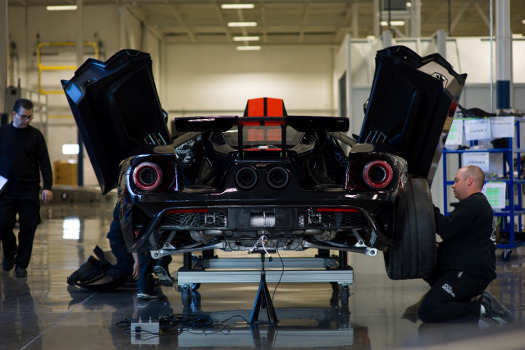
One of the first Ford GTs before being driven off the line at the Multimatic assembly location. The car is the culmination of years of Ford innovation in aerodynamics, lightweight carbon fiber construction, and ultra-efficient EcoBoost engines. Pictured: Anthony Benincasa (left) and Adam Thorndyke. [Photo: Nick Busato]
Some 2017 Ford GT Tech Specs
SAE-rated at 647 hp and with 550 lb-ft. of torque, Ford's new high-output 3.5-liter V6 powerplant produces the most horsepower of any EcoBoost production engine ever, making Ford GT the fastest production car ever to wear the Blue Oval badge. The engine's wide powerband produces 90 percent of its peak torque from 3,500 rpm.
The Ford GT merges its muscle power with some impressive aerodynamic efficiency and advanced active dynamics to achieve a maximum speed of 216 mph -- making it the fastest Ford production vehicle on the track ever.
The supercar is designed and optimized for track performance to honor its racing heritage. In 2016 development testing, with all contenders track-prepped with new fluids, fresh tires, and optimal suspension settings, in identical conditions and with the same driver behind the wheel, Ford GT bested both the McLaren 675LT and Ferrari 458 Speciale at Calabogie Motorsports Park in Canada.
Here are the results:
- Ford GT: 2:09.8
- McLaren 675LT: 2:10.8
- Ferrari 458 Speciale: 2:12.9
"We tested and developed this powertrain through the Daytona Prototype race car that ran in IMSA for two seasons, last season racing with Ford GT," said Dave Pericak, global director, Ford Performance.
Ford GT's dry weight just tops 3,000 lb, which places the supercar between its two primary competitors, the McLaren 675LT and Ferrari 488. Ford GT's power-to-weight ratio is 4.72 lb/hp.
"We achieved considerable weight savings with the carbon fiber architecture," said Raj Nair, Ford executive vice president, global product development and chief technical officer. "We then reinvested some of that savings into where it counts most: performance. Specifically, the active dynamics. The result is an even faster car."

[Photo by: Sam VarnHagen]
The active dynamics systems, for both suspension and aerodynamics, are designed to make the car perform with optimum downforce, drag, and balance at any speed, creating a faster setup regardless of driver skill level.
The production Ford GT shares a great deal with the high-performance track version, with advanced aero and suspension features added that take it to another level.
For more information, visit www.FordGT.com.
Source: Ford Motor Company
Published Janury 2017
Rate this article
View our terms of use and privacy policy
